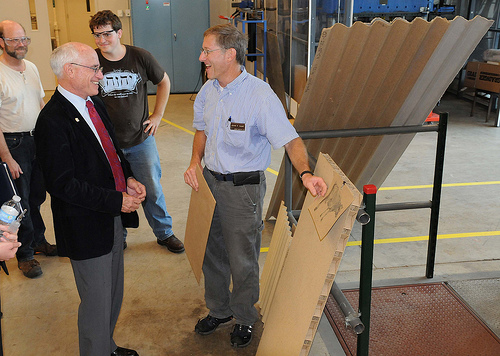
USDA Under Secretary Harris Sherman (front left) meets with FPL researcher John Hunt (front right) as representatives from FPL partner Noble Environmental Technologies look on (in background, Jim Jensen and Caleb Walker).
A recent visit to the US Forest Service Forest Products Laboratory by USDA Under Secretary Harris Sherman was an eventful one. Sherman took the opportunity to visit with industry leaders who have collaborated with federal scientists to bring innovative new products to the market. Sherman was at the laboratory on July 25 for a grand opening of the new Nanocellulose Pilot Plant along with scores of industry leaders, scientists and academic researchers. Read more »
The U.S. Forest Service Forest Products Laboratory recently opened a $1.7 million production facility for renewable, forest-based nanomaterials. This facility is the first of its kind in the United States and one that positions the laboratory as the country’s leading producer of these materials, also called nanocellulose.
Nanocellulose is simply wood fiber broken down to the nanoscale. For perspective, a nanometer is roughly one-millionth the thickness of an American dime. Materials at this minute scale have unique properties; nanocellulose-based materials can be stronger than Kevlar fiber and provide high strength properties with low weight. These attributes have attracted the interest of the Department of Defense for use in lightweight armor and ballistic glass. Companies in the automotive, aerospace, electronics, consumer products, and medical device industries also see massive potential for these innovative materials. Read more »
Cross posted from the White House Council on Environmental Quality blog:
I was recently in Atlanta, Georgia to speak at the North American Wildlife and Natural Resources Conference about Working Lands for Wildlife, a new effort to focus both conservation dollars and wildlife management expertise on the recovery of seven at-risk, threatened or endangered wildlife species. This unique approach to conservation concentrates federal resources on private working lands—home to a majority of candidate and listed species under the Endangered Species Act. Working Lands for Wildlife was developed by the Department of Agriculture and the Department of the Interior through their membership in the White House Rural Council.
Working with farmers, ranchers and forest landowners is critical to President Obama’s vision of an economy built to last, one where rural communities provide clean air, clean water and wildlife habitat to generate economic opportunities for outdoor recreation and jobs, while protecting farm and ranch traditions. Working Lands for Wildlife demonstrates the President’s focus on the rural economy and his commitment to keep working lands working. Read more »

The legacy of the Weeks Act is shown by looking at photos of the White Mountain National Forest a century apart. Nearly a 100 years later after being decimated by logging, this photo depicts a healthy restored forest at the same location.
The Weeks Act, which went into effect on March 1, 1911, has been identified as one of the most important pieces of environmental legislation in American history.
In the early 1900s the public began to embrace a more proactive attitude toward conserving public lands. Just the year before, in 1910, Gifford Pinchot started the Forest Service. Before the Weeks Act, lands set aside for conservation were all located in the West and were created from large blocks of land in the public domain. Millions of acres of bare, eroded lands dotted the Eastern states from cut-over and farmed-out lands. In the West, the epic wildfires of 1910 fueled support for the Act. Read more »
We have a resource issue across the West, and here in Nevada in particular, that is crossing a number of boundaries in terms of its effects on rural economies, wildlife diversity and forest health. That issue is pinyon-juniper encroachment; which is the rapid growth of pinyon and juniper trees to the extent that risks of disease, insects and catastrophic fire intensify, and diversity of forage and wildlife are threatened. Extensive forest canopy blocks all of the light and plant life below, reducing the productivity of the land for both man and beast. Each year in Nevada, another 100,000 acres of P-J woodland converts to the highest density Pinyon-Juniper forest. Read more »

Accepting the ACHP Award for Federal Preserve America Accomplishment given for a series of youth summits in Colorado at the Advisory Council on Historic Preservation quarterly business meeting in Washington D.C. on Sept. 16, 2010 were, from left: Undersecretary for Natural Resources and Environment Harris Sherman, Department of Agriculture; Secretary of the Interior Ken Salazar; Ann Pritzlaff, on behalf of Colorado Preservation, Inc., the Colorado Historical Society, and herself. Presenting the award was ACHP Chairman Milford Wayne Donaldson (right). The youth summits were made possible due to participation and support from units of the National Park Service, the Bureau of Land Management, and the U.S. Forest Service in Colorado. Photo courtesy of Tami Heilemann, National Business Center, Department of the Interior.
The Forest Service played an integral role with USDA and DOI being selected as recipients of the Advisory Council on Historic Preservation (ACHP) Award for Federal Preserve America Accomplishment.
On Sept. 16, both Departments were recognized at a ceremony in Washington, D.C. for their outstanding support for Colorado Preserve America Youth Summits over the past five years provided by the Forest Service, National Park Service (NPS) and Bureau of Land Management (BLM).
The ACHP and its partners have been working proactively to involve and educate youth in natural and cultural historic preservation activities and increase participation and diversity. To date, there have been five successful Colorado Youth Summits, which included active participation of Forest Service, NPS and BLM employees in the state.



